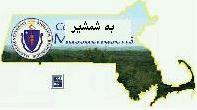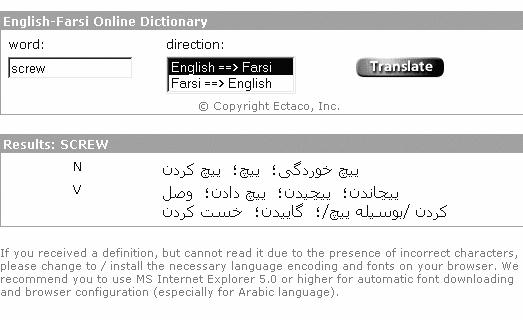

"Windows Persian" means Windows Arabic (Codepage 1256) plus five additional glyphs for the Iranian market. These glyphs are all in the fonts that come with the Arabic Text Support module associated with Microsoft Internet Explorer 5. Four of them (the indispensible ones) have been around as long as the "localized" or "enabled" Arabic Windows 95 product of 1996.
But where is the sign of anybody ever doing anything with them? Out in WWWonderland, one uncovers vastly less Persian than Arabic, and what there is of the latter almost always comes as artwork, not character-based text. Sometimes as pure homebrew artwork, sometimes as PDF files, but scarcely ever as Windows Persian. Indeed, when this document gets posted perhaps an hour from now, there will be half again as many Windows Persian webpages in the world, for we know of only two others, both very specialized and peculiar in much the same way that this page is. That is, they are both about how one can do Persian or Persian Windows, not about something less boring and more bloody and extralinguistic, like, say, the history of Jenghiz Khan and Company.
First comes our own original contribution. We ourselves do not need to quest for Windows Persian in the sense of becoming "enabled" to generate it. We have only to type it in with the "Arabic (Massachusetts) 101-Key" keyboard and place the mantra
{ meta http-equiv=Content-Type content="text/html; charset=windows-1256" }
at the top of this page of HTML. Microsoft Corporation will take care of the rest.
Here, to begin with, are the Gang of Four-and-a-half:
پ چ ژ گ ک
As usual, Microsoft doesn't get these things altogether right. Although it is mildly nice to have an absolute/final كاف without the thingumabob the Arabs write inside it, it would have been more useful to have a هاء with a همزة on top of it to write certain kinds of إضافه with. Aha! this is another pretty case of self-referentiality, like the main page's discussion of شدّة in the "Xlit1256" font! One can only write
اضافه ِ اين جنس
with a practically invisible vowel in it, when the ideal would be

In comparison with that issue and above all the omission to supply any keyboard access, it is trivial nitpicing to complain that the fonts Microsoft hides the Persian glyphs in do not look at all Persian. By default, IE5 executed everything so far as "Tahoma," but that may depend on the settings of particular browsers. Let us look at a verse explicitly cast into all four of the Redmond standard fonts.
بـوى جـوى مـوليان آيـد هـمي * يـاد يـار مـهربان ايـد هـــمي
"Arial"
بـوى جـوى مـوليان آيـد هـمي * يـاد يـار مـهربان ايـد هـــمي
"Courier New"
بـوى جـوى مـوليان آيـد هـمي * يـاد يـار مـهربان ايـد هـــمي
"Tahoma"
بـوى جـوى مـوليان آيـد هـمي * يـاد يـار مـهربان ايـد هـــمي
"Times New Roman"
Needless to say, a really Persian version would look more like
Now as to those other two "Windows Persian" webpages,
Trigeminal Software, Inc. is a software development and consulting company focusing on software solutions using: Microsoft Visual C++ 6.0 (and 7.0!) Microsoft Visual Basic 6.0 (and 7.0!) Microsoft SQL Server 7.0 and 2000 Microsoft Jet 3.5x and 4.xx Microsoft Access 97 and 2000 Microsoft Internet Information Server/Active Server Pages
That excerpt from the parent page should be quite enough to indicate what sort of folks these are, and with what large USA corporation intervolved. Also they are the sort who haven't fixed that fouled-up UDRU line of their
"Why Can't They Just Speak ______?"
webpage, even though we happen to know they were advised about it weeks ago.And then there is

where the IE5 "View\Source" procedure allows one to extract the following:
{font class="arabic" size="+2"} پيچاندن؛ پيچيدن؛ پيچ دادن؛ وصل كردن /بوسيله پيچ/؛ گاييدن؛ خست كردن {/font}
To which we append a screenshot of the HTML for the above line with the Persian (and the English and the HTML) shown in the "Xlit1256" font:

It must be admitted that HTML (or rather, IE5 performing HTML) doesn't always do mixed right-left and left-right material ideally correct. Possibly you noticed something slightly ahoo with the date of this document at the top of the page?
To conclude, here is (1)
a very literary document indeed, which shows some Windows Persian text prepared by WinWord 9. Don't try to download that one if you don't have Microsoft Office 200X. And (2), a link to
http://www.gooya.com/
"The Most Useful Persian Media" ,
And finally, (3), since Osmaniyyeh was pretty much the same language as Persian, if it was ever exactly any language at all, why not a webpage of it? Behold Massachusetts Windows Turkish!